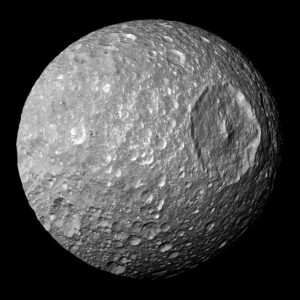
I want to alert you to a cool paper about Saturn’s icy Moon Mimas. Published in Nature with first author Valéry Lainey, this paper calls attention to Mimas’ weird orbit that is changing over time in ways that just don’t match how a solid object should behave.
There is a lot of complex physics here, but it all kind of comes down to something called a moment of inertia. If you have a raw egg and a hard-boiled egg, you can set them spinning side by side and they will spin very differently. Orbiting objects are more complex than objects like eggs or tops that you can spin on your table, but it’s all math that can be done. When this team tried to work out the internal structure of Mimas, they discovered it had to include an ocean lurking tens of kilometers beneath the icy surface.
What’s more, this object isn’t stable in ways you’d expect if it had been that way since it formed. Instead, by looking at its motions and thermodynamics, they were able to work out that it has only had this ocean for about five to fifteen million years. The paper has less than two pages of text, so they didn’t have space to explain a lot of the details – and without giving you a grad class in physics I’m not sure I could explain the details – but this is just cool. They were able to figure out that at some point after megafauna started walking the Earth and before humans started wandering Africa, a new ocean formed inside a moon of Saturn.
They aren’t clear on how this happened. It wasn’t caused by whatever created Mimas’ signature crater; at least, that option isn’t listed in the paper. Most likely, the world had a close interaction with one or more of Saturn’s other moons, and these interactions shifted Mimas into a more eccentric orbit and heated it.
So, if you want to see what can exist in an ocean that is only 5-50 million years old, Mimas has you covered.
